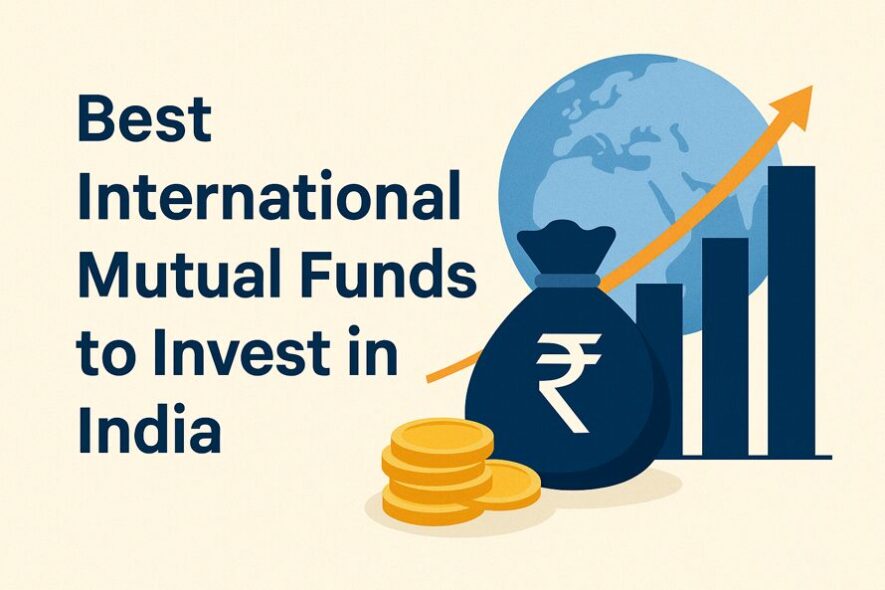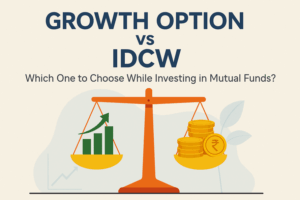SIP Calculator
×
Best International Mutual Funds to Invest in India

Introduction to International Mutual Funds
Looking beyond Indian markets to invest? International mutual funds provide you with that opportunity without the hassle of having to set up foreign brokerage accounts. These are India-based mutual funds managed by domestic AMCs, but the money gets invested overseas. No need to pick and track individual global stocks. You simply buy units in a fund, and that fund does the heavy lifting by investing in foreign equities, ETFs, and sector-specific opportunities abroad.
Think of it this way: You’re getting a piece of Apple, Tesla, Nestlé, or Alphabet, without even leaving your Indian AMC dashboard. You get exposure to the US innovation ecosystem, Europe’s luxury sector, and Asia’s industrial growth. That’s a global buffet served on your Indian plate.
Of course, this comes with its own learning curve. You’ll deal with foreign currency exposure, market timing risks, and the occasional turbulence in global geopolitics. Plus, there are SEBI-imposed limits on how much Indian mutual funds can deploy abroad. Still, for long-term investors seeking to diversify their investments, international mutual funds offer a good opportunity.
Why Should You Invest in International Mutual Funds?
“Start investing with confidence! Explore the best
mutual funds
and grow your wealth.”
Global Diversification
Investing solely in the Indian market is akin to limiting your exposure to the domestic market. International mutual funds let you diversify into global equities.
When Indian equities hit a rough patch, global markets might be booming. The US may be riding a tech wave. Europe might be expanding its renewable energy goals. China could be on the cusp of an economic rebound. With international mutual funds, you get a seat at all those tables. It’s not about chasing every opportunity; it’s about reducing concentration risk and spreading your exposure sensibly.
And let’s not forget the big names. With the right fund, you get exposure to companies that drive global consumer behavior, such as Apple, Amazon, Google, Tesla, Microsoft, Samsung, or even luxury goods giants like LVMH. These brands have reach, resilience, and revenue that span nations. Including them in your portfolio adds muscle.
Currency and Market Exposure
Now here’s something that catches many by surprise: currency movements. When you hold foreign assets through international mutual funds, you automatically gain exposure to currencies like the Dollar, Euro, or Pound. If the Indian Rupee dips (which, historically, it often has), your investments overseas could become more valuable in INR terms.
It’s like getting a double benefit, first from the potential rise in foreign market prices, and second from a favorable currency conversion. Imagine the US market grows by 10%, and the Rupee weakens 5% against the Dollar, that’s a 15% translated gain in your portfolio.
Also, each market has its rhythm. While Indian small-caps might take a breather, US tech giants might sprint ahead. Europe’s green energy sector could skyrocket while Indian banks stay stable. International mutual funds plug you into these contrasting cycles. You aren’t relying on one economy’s momentum; you’re drawing power from many.
Hedging Against Domestic Risks
Here’s the real talk. Every country faces hiccups. And India is no exception. Inflation shocks, political overhauls, currency swings, and tax changes all affect your local investments. That’s where international mutual funds come in handy.
When your domestic portfolio stumbles, global assets often step in to steady the ship. Think of it as a counterbalance. Maybe India rolls out a sudden import duty or changes interest rates overnight, your global investments likely won’t flinch.
Let’s say Indian mid- and small-cap stocks drop due to a regulatory crackdown. If your portfolio also holds a US-based healthcare fund or a global AI-focused ETF, you might still see growth, or at least stability. You’re giving your money room to breathe beyond one country’s borders.
More importantly, you’re taking control of portfolio volatility. You’re ensuring that a single event in India doesn’t throw your entire plan off course. That’s long-term thinking, and that’s what global diversification is really about.
Types of International Mutual Funds Available in India
Feeder Funds
Feeder funds are a beginner-friendly route to global investing. Here, an Indian AMC (Asset Management Company) launches a fund that simply “feeds” investor money into a large, professionally managed overseas fund. This master fund could track global indices like the S&P 500, MSCI World Index, or Nasdaq 100.
The advantage? You don’t have to handle foreign transactions or regulatory processes. Everything, from currency conversion to compliance, is managed for you. Feeder funds mirror the performance of the master fund, with only minor variations due to local expenses. This model is ideal for Indian investors seeking to track high-performing global indices passively without complexity.
Fund of Funds (FoFs)
Want global reach without picking every market yourself? Fund of Funds (FoFs) do just that. They pull together multiple international mutual funds into one umbrella product, so you get exposure to different geographies, sectors, and strategies all at once.
One FoF might include a slice of Silicon Valley tech, a chunk of European infrastructure, and a piece of Asia’s consumer growth, all inside one SIP. You don’t have to chase the right market. It’s already baked into the mix.
Behind the scenes, expert fund managers blend these combinations with research-driven insights. They rebalance when needed, so your money stays aligned with global market movements. That said, because there’s a fund managing other funds, costs stack up a little. Double layers of management mean the expense ratio runs slightly higher than that of other international funds. Still, for many hands-off investors, the convenience and built-in diversification outweigh the extra cost.
Direct Overseas Equity Funds
Direct Overseas Equity Funds skip the intermediary. Your money goes straight into foreign stocks or ETFs, no feeder structures, no FoFs. Fund managers call the shots here. If they spot a spike in German industrials or a dip worth buying in South Korean semiconductors, they move fast.
That means more agility, more control, and in many cases, better precision in capturing global trends. You aren’t tied to what the master fund overseas decides; you’re backed by active management from your Indian AMC.
Of course, this active model comes with higher responsibility. And higher fees. Managers need to do deep research, have global access, and make quick decisions. These funds are best suited for those with a higher risk appetite and the patience to navigate international market cycles. But if you want direct access and real-time tactical shifts, this path keeps you closest to global action.
Thematic and Sector-Specific International Funds
This one’s for the believers. If you’re bullish on electric vehicles, clean energy, AI, biotech, or luxury retail, thematic international funds let you double down. They focus on sharp ideas and global trends by investing only in companies aligned with a single theme or sector.
Think: funds centered on the Nasdaq 100, global healthcare, or green infrastructure. The upside? You ride the wave when your chosen sector booms. The catch? That wave can also pull back. Think of the dotcom bubble at the turn of the millennium.
These funds pack more punch, but also more volatility. That’s why seasoned investors treat them as satellite plays, not core holdings.
Top Performing International Mutual Funds in India (2025)
Here are some top international mutual funds in India as of 2025, with their five-year returns and expense ratios:
| Fund Name | 5-Year Return | Expense Ratio | Risk Profile |
|---|---|---|---|
| Invesco Global Equity Income Fund of Fund Dir Growth | 20.03% | 0.87% | Very High |
| Edelweiss US Technology Equity Fund of Fund Direct Growth | 19.93% | 1.50% | Very High |
| Motilal Oswal Nasdaq 100 Fund of Fund Direct Growth | 19.76% | 0.21% | Very High |
| DSP US Specific Equity Omni FoF Direct Plan Growth | 19.47% | 1.49% | Very High |
| Motilal Oswal S&P 500 Index Fund Direct Growth | 19.14% | 0.61% | Very High |
Data Source: Coin by Zerodha, Groww, ET Money
These funds have performed well in favourable global conditions (especially tech, growth sectors in the US). Be aware that past performance doesn’t guarantee future returns, especially given currency and regulatory risks.
Key Factors to Consider Before Investing
Expense Ratios and Taxation
Higher expense ratios eat into net returns. Also, taxation of international funds differs from that of domestic equity funds. International funds are often classified as non-equity (or debt style) for tax purposes, meaning short-/long-term gain rules differ.
Risk and Volatility Factors
Global markets jump more with global events (US Fed rate hikes, geopolitical tension). Sector-specialized funds (like US tech or European financials) have higher volatility. As an investor, ask whether you can stomach portfolio swings of 20-30% in a year.
Currency Risk and Global Market Trends
Exchange rates matter. If INR depreciates in relation to USD, Indian investors with exposure to US stocks stand to gain. Any incremental fall in INR adds to your portfolio gains when converted back to INR.
Regulatory Limits on Overseas Investment
SEBI has imposed caps on overseas investments: an industry-wide limit of USD 7 billion for mutual funds to invest overseas. Also AMC-specific caps, and rules on feeder funds & FoFs. Some international mutual funds stopped accepting fresh investments when caps were reached.
How to Invest in International Mutual Funds in India
Through Mutual Fund Platforms and AMCs
AMCs like Motilal Oswal, Edelweiss, and DSP offer global or international FoFs. To invest in these funds, use investing platforms like Lemonn or invest directly via AMC websites. Check if a scheme is open for fresh subscriptions. Some are closed as they hit regulatory caps.
Via Direct and Regular Plans
Direct plans generally have lower expense ratios (no distributor commission). If you’re comfortable doing your own research, go for direct plans. Regular plans cost more but offer ease via intermediaries.
Using SIPs vs Lump Sum Investments
SIPs (Systematic Investment Plans) help spread risk: you buy units monthly or quarterly, so you average purchase cost over time. Lump sum works well if you believe global markets are undervalued. However, a lump sum also risks buying at the peak.
Taxation of International Mutual Funds in India
Debt Fund Classification and LTCG/STCG Rules
International mutual funds are usually taxed as non-equity funds (similar to debt funds) unless they meet specific criteria. Short-term capital gains from holdings held for 3 years are taxed at the investor’s slab rate. For long-term gains, the LTCG rate is 12.5% without indexation for a holding period of two years.
Double Taxation Avoidance Agreement (DTAA)
If the international fund or overseas underlying investments pay taxes in a foreign country (like withholding tax on dividends), DTAA helps avoid paying tax twice. You may get a tax credit, depending on the country. Always check the fund’s disclosures and whether that country has a DTAA with India.
Risks Associated with International Mutual Funds
- Currency fluctuations can eat into returns.
- Regulatory caps may limit fresh investments in some funds.
- High expense ratios due to overseas brokerage and fund management.
- Thematic or sector-specific international funds are more volatile.
- Overseas political or economic changes (tariffs, local laws) can impact underlying assets.
Conclusion
International mutual funds offer Indian investors a chance to access global growth, diversify, and hedge domestic risks. The top funds listed above show that returns of 19-20% annually are possible in favourable conditions. But returns bring risks: currency, regulation, taxation.
Before investing, check the expense ratio, tax rules, regulatory limits, and your own risk tolerance. If you use SIPs, prefer direct plans, and keep a mix with domestic funds to build a resilient portfolio. Think global, but stay aware.
FAQs:
Q. Are international mutual funds safe for Indian investors?
SEBI-regulated Indian AMCs manage international mutual funds, so they follow all domestic compliance rules. The core risk comes from currency swings, market volatility, and global economic events. They’re safe from a regulatory angle, but like any equity investment, they carry market-linked risk.
Q. How are international mutual funds taxed in India?
These funds fall under debt taxation rules, even though they invest in equities. That means if you redeem units within 3 years, gains are taxed as short-term capital gains at your income tax slab. For long-term capital gains, the tax rate is 12% without indexation if held for 2 years.
Q. What are feeder funds, and how do they work?
Feeder funds are Indian mutual funds that invest in a single foreign fund (called the master fund). They simply replicate the returns of that master fund, minus expenses and currency impact. You don’t own international stocks directly, but you get indirect exposure through that overseas fund.
Q. Can I invest in the US stock markets via Indian mutual funds?
Yes, many Indian mutual funds offer access to US markets, especially through feeder funds and international FoFs. Some target the S&P 500, Nasdaq 100, or large-cap US tech companies. You don’t need a US trading account. Just invest in rupees through your regular mutual fund platform.
Q. What are the SEBI limits on overseas investments?
SEBI has capped the limit for overseas investment of mutual funds at $7 billion at an industry level. The cap is $1 billion for an individual mutual fund house. A separate $1 billion cap applies to investments in overseas exchange-traded funds (ETFs).
Q. Which is better, international mutual funds or ETFs?
ETFs offer lower costs and real-time trading flexibility, but they require a demat account and active monitoring. International mutual funds are easier to buy, manage, and invest in through regular platforms, even if slightly more expensive. The better choice depends on your comfort with DIY investing vs. managed exposure.
Disclaimer
The stocks mentioned in this article are not recommendations. Please conduct your own research and due diligence before investing. Investment in securities market are subject to market risks, read all the related documents carefully before investing. Please read the Risk Disclosure documents carefully before investing in Equity Shares, Derivatives, Mutual fund, and/or other instruments traded on the Stock Exchanges. As investments are subject to market risks and price fluctuation risk, there is no assurance or guarantee that the investment objectives shall be achieved. Lemonn (Formerly known as NU Investors Technologies Pvt. Ltd) do not guarantee any assured returns on any investments. Past performance of securities/instruments is not indicative of their future performance.







